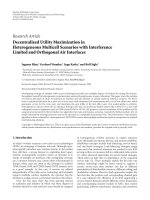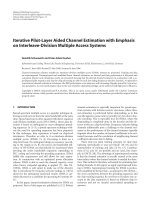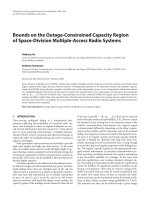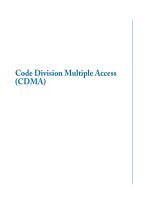Inter carrier interference suppression in orthogonal frequency division multiple access (OFDMA) systems uplink
Bạn đang xem bản rút gọn của tài liệu. Xem và tải ngay bản đầy đủ của tài liệu tại đây (1.04 MB, 138 trang )
Inter-Carrier Interference Suppression in
Orthogonal Frequency Division Multiple Access
(OFDMA) Systems Uplink
Hou Sheng-Wei
B.Eng., University of Science & Technology of China
A Dissertation submitted to the Department of Electrical & Computer Engineering in
partial fulfillment of the requirements for the degree of Doctor of Philosophy
at
National University of Singapore
2008
i
Acknowledgements
At the end of my PhD study at the National University of Singapore, I would
like to give my sincerest gratitude to my supervisor during the last three years,
Professor Ko Chi Chung, for his guidance and assistance throughout the whole
candidature. Not only this thesis and my research work, but also my personal
development at NUS have benefited from his insight and support. It is my fortune
to receive this valuable experience, without which none of what I have today would
come true.
My parents, who always stand beside me, have given me their greatest
understanding and support in all these years. Special thanks to my mother, she
devotes her life to my education and always gives me the courage to face
challenges, all of which have become stepping stones leading to the future.
Also, I am very thankful to the officemates at Communications Lab for their
great friendship through my study at Singapore.
ii
Contents
Acknowledgements i
Contents ii
List of Figures v
List of Tables vii
List of Abbreviations viii
Summary ix
Chapter 1 Introduction 1
1.1 OFDM-based Wireless Communications 2
1.1.1 Principles of OFDM 2
1.1.2 OFDM-based Multiple Access 5
1.2 OFDMA: Advantages and Challenges 8
1.3 Inter-Carrier Interference Suppression in OFDMA Uplink 9
1.4 Outline 12
Chapter 2 Inter-Carrier Interference in OFDMA System Uplink 13
2.1 Frequency Asynchronism and ICI in OFDMA Uplink 13
2.2 A Review on Current ICI Suppression Approaches 14
2.2.1 Conventional Detector 14
2.2.2 Supplementary Schemes based on Conventional Detection 16
2.2.3 Non Conventional Detector-based Schemes 16
2.3 Problem Definition 17
2.3.1 Near-far Problem in OFDMA Uplink 18
2.3.2 ICI Suppression in Time-selective Fading Channels 18
Chapter 3 ICI Suppression in Doubly Selective Fading Channels 20
3.1 Time and Frequency Selective Fading Channels 20
3.1.1 Multipath Propagation and Frequency Selective Fading 21
3.1.2 Time Variation and Time Selective Fading 22
3.2 OFDMA Signal in Doubly Selective Fading Channels 22
3.3 ICI Suppression for OFDMA Uplink 27
iii
3.3.1 Matched Filtering 27
3.3.2 Zero Forcing 30
3.3.3 MMSE 31
3.3.4 MMSE Successive Detection 35
3.4 Performance Analysis 37
3.4.1 Post-detection SINR 37
3.4.2 Sensitivity to Channel Estimation Error 38
3.5 Numerical Results and Discussions 39
Chapter 4 BEM based Channel Estimation for OFDMA Uplink 45
4.1 Current OFDMA Uplink Channel Estimation Schemes 45
4.2 Basis Expansion Model for OFDMA Uplink Channels 47
4.2.1 An Overview on Modeling Doubly Selective Fading Channels 47
4.2.2 Basis Expansion Model 49
4.2.3 BEM-based Signal Model for OFDMA Uplink 52
4.3 BEM-based Channel Estimation for OFDMA Uplink 54
4.3.1 Time-domain Estimation 54
4.3.2 Interpolation Algorithms 56
4.3.3 Frequency-domain Estimation 58
4.4 CRLB Analysis for LS Estimators 63
4.5 Numerical Results and Discussion 66
4.5.1 Performance of Estimation 67
4.5.2 Performance of ICI Suppression with Channel Estimation 71
Chapter 5 Low Complexity ICI Suppression in Interleaved OFDMA System
Uplink 75
5.1 Signature Vectors in Interleaved OFDMA Signaling 76
5.2 Signature Vector-based Multiuser Detection 81
5.2.1 Matched Filtering 82
5.2.2 Zero Forcing 84
5.2.3 MMSE 86
5.2.4 Performance Analysis and Discussion 87
5.3 Numerical Results 94
Chapter 6 Conclusions and Future Work 102
iv
6.1 Conclusions 102
6.2 Future Work 104
Appendix A 107
Appendix B 109
Appendix C 111
Appendix D 113
Appendix E 115
Bibliography 116
List of Publications 127
v
List of Figures
Fig.1.1: Spectra of an OFDM-modulated Signal. 2
Fig.1.2: A Cyclic Prefix used in an OFDM system 4
Fig.1.3: Block diagrams of (a) OFDM transmitter with a single antenna (b) OFDM receiver
with a signal antenna 5
Fig.1.4: Typical multiple access techniques used with OFDM 7
Fig.2.1: (a) Conventional OFDMA detector (b) Low-complexity variant based on post-FFT
circular convolution. 15
Fig.3.1: Transmitter block diagram for each user in an OFDMA uplink. 22
Fig.3.2: Near-far effect simulation system setup 28
Fig.3.3: Probability density function of post-MF SINR. 29
Fig.3.4: Noise enhancement of zero forcing ICI suppression 31
Fig 3.5: Noise enhancement characteristic of MMSE ICI suppression. 35
Fig.3.6: Flowchart of MMSE-SD detection 36
Fig.3.7: Average symbol error rates versus SNR with perfect CIR. 40
Fig.3.8: Average symbol error rates versus
d
f
T with perfect CIR. 42
Fig.3.9: Symbol error rate against Interference Signal power Ratio 43
Fig.3.10: Post-MMSE SINR versus channel estimation MSE 44
Fig.4.1: Delay-tapped line representation of doubly selective fading channel. 47
Fig.4.2: Sampling in Doppler frequency domain and BEM representation of time-varying
channel. 50
Fig.4.3: Mean Square Error (MSE) of BEM modeling versus oversampling index. 51
Fig.4.4: Pilot pattern for time-domain estimation 54
Fig.4.5: (a) Pilot pattern in mobile WiMAX uplink, (b) A tile 59
Fig.4.6: Samples selection for channel estimation from FFT-demodulated OFDMA block 62
Fig.4.7: MSE performance of LS-T and LMMSE. 68
Fig.4.8: Comparison between LS-T and LS-F 69
Fig.4.9: Average MMSE versus pilot block length. 70
Fig.4.10: Average symbol error rates of MMSE and MMSE-SD with channel estimation 71
Fig.4.11: Average symbol error rates of MMSE and MMSE-SD under different CFO ranges
with channel estimation 72
Fig.4.12: Immunity to CFO estimation errors with channel estimation 73
Fig.4.13: Symbol error rate against Interference Signal power Ratio 74
vi
Fig.5.1: Interleaved OFDMA subcarrier allocation, each bar stands for one subcarrier 76
Fig.5.2: (a) Novel parallel detection structure for the interleaved OFDMA uplink (b) ICI
suppression and Doppler diversity combining for each user. 80
Fig.5.3: Signature-vector based detector in static and quasi-static fading channels. 81
Fig.5.4: output SIR PDF of the conventional OFDMA detector. 83
Fig.5.5: Complexity comparison for the PIC, SB-ZF and MMSE detectors. 92
Fig.5.6. Performance comparison between the constrained and unconstrained LMS algorithms
in a decision-directed mode 94
Fig.5.7: BER performance comparison of the MMSE and PIC detectors with and without
power control. 96
Fig.5.8: BER performance for different number of users under perfect power control 96
Fig.5.9: BER performance in a time-selective multipath Rayleigh fading channel with
differential modulation 97
Fig.5.10: Output SINR versus CFO estimation errors. 98
Fig.5.11: Output SINR versus input SIR with CFO estimation. 99
Fig.5.12: BER performance under random CFO test 100
Fig.5.13: BER performance of the SB-ZF and the MMSE scheme under different
0b
E
N 101
vii
List of Tables
Table 1-1. Comparison of OFDM-based Multiple Access Schemes 8
Table 3-1. MMSE-Successive Detection (MMSE-SD) 37
Table 3-2: Post-Detection SINR for ZF and MMSE 37
Table 5-1. Complexity in terms of Multiplications 91
Table 5-2. LMS Algorithms For MAI Suppression 93
viii
List of Abbreviations
4G fourth generation (communication
technologies)
MIMO multiple input multiple output
BEM basis expansion model ML maximum likelihood
BER bit error rate MMSE minimum mean square error
BS base station MS mobile station
CDMA code division multiple access MSE mean square error
CFO carrier frequency offset OFDM orthogonal frequency division
multiplexing
CP cyclic prefix OFDMA orthogonal frequency division
multiple access
CRLB Cramer-Rao Lower Bound PIC parallel interference cancellation
DFT discrete Fourier transform P/S parallel to sequential
FDMA frequency division multiple access QPSK quaternary phase shift keying
FFT fast Fourier transform SDMA space division multiple access
IBI inter-block interference SB subspace
ICI inter-carrier interference SER symbol error rate
IFFT inverse fast Fourier transform SIC successive interference
cancellation
ISI inter-symbol interference SIR signal-to-interference power ratio
LMMSE linear minimum mean square error SINR signal-to-interference-plus-noise
power ratio
LMS least mean square SNR signal-to-noise power ratio
LS least square S/P sequential to parallel
MAI multiple access interference TDMA time division multiple access
MF matched filtering WiMAX worldwide interoperability
microwave access
ix
Summary
In current broadband evolution of wireless communications, Orthogonal Frequency
Division Multiplex (OFDM) is widely accepted as a major technique for many future
broadband wireless systems. OFDMA, a multiuser OFDM using Frequency Division
Multiple Access (FDMA), becomes a paramount candidate to support multiple access in
future broadband wireless systems due to its advantages over existing multi-access
techniques.
In uplink transmission, OFDMA suffers from Inter-Carrier Interference (ICI)
caused by subcarrier frequency misalignment, which can be due to Carrier Frequency
Offset (CFO) and Doppler effects. In particular, different users have independent
frequency misalignment and thus CFO compensation used in single-user OFDM fails to
suppress the ICI in an OFDMA system. In this dissertation, the use of multiuser
detection schemes is developed to suppress ICI at the receiver after transmission through
time and frequency selective channels. Both linear and non-linear detection techniques
are considered and investigated. Minimum Mean Square Error (MMSE) and MMSE
with Successive Detection (MMSE-SD) are proposed for possible use in OFDMA
uplink. It is shown that the MMSE scheme is optimal linear scheme in terms of
maximizing system rate, and the MMSE-SD is capable of exploiting the Doppler
diversity from time-varying channels.
Since channel information is requisite knowledge to ICI suppression, estimation of
the doubly selective fading channel is investigated in Chapter 4. To avoid performance
x
degradation caused by ICI in frequency domain, a time domain estimation scheme is
proposed based on Basis Expansion Model. Both analytical and simulation results
demonstrate that the proposed scheme obtains significant accuracy improvement.
Moreover, the proposed ICI suppression schemes used in conjunction with the proposed
channel estimation scheme are also evaluated.
Chapter 5 particularly presents a study on interleaved OFDMA system uplink, since
a novel signal model can be designed in such a system, which obtains low complexity in
ICI suppression. The design is considered in a static multipath fading channel and
compared with current studies. Analytical and simulation results are presented to
demonstrate that performance can be improved with reduced complexity.
In summary, this dissertation presents two important issues in physical layer design
of OFDMA system. Improved ICI suppression and channel estimation schemes are
proposed and analyzed for the use in mobile applications with time and frequency
selective fading channels.
1
Chapter 1
Introduction
An explosive increase in the demand on multimedia information has lately
motivated a high-data-rate evolution in wireless industry characterized by the change
from narrowband to broadband. Under this evolution, signal modulation techniques
will also be changed from single-carrier modulation to multicarrier modulation [1].
Conventional single-carrier modulation suffers from Inter-Symbol Interference (ISI) in
a multipath fading channel and thus shows obvious limitation when used in broadband
high-rate systems. Complicated channel equalization techniques are needed to remove
the ISI in order to maintain performance. On the other hand, the use of multicarrier
modulation is able to improve system immunity to multipath fading, because a
high-rate data stream is separated into several low-rate data streams which are
transmitted through different subcarriers. Design of channel equalization techniques in
a multicarrier system thus can be dramatically simplified.
Amongst various multicarrier modulation schemes, Orthogonal Frequency
Division Multiplexing (OFDM) has become a popular scheme since it can be readily
implemented through a Fast Fourier Transform (FFT) module. OFDM also becomes a
prime theme in the evolution towards future broadband wireless technologies and a
promising candidate in several broadband wireless systems, such as Universal Mobile
Telecommunications System (UMTS)[2], IEEE 802.11 and IEEE 802.16 [3]-[6].
2
1.1 OFDM-based Wireless Communications
1.1.1 Principles of OFDM
In OFDM modulation, a series of information symbols are placed onto uniformly
spaced orthogonal subcarriers (the subcarriers that are orthogonal to each other during
signaling interval). Fig.1.1 depicts the spectrum of an OFDM-modulated signal. To
attain highest spectra efficiency, the spacing between subcarriers is chosen to be the
smallest distance that ensures orthogonality.
Fig.1.1: Spectra of an OFDM-modulated Signal.
A. FFT Implementation of OFDM
Let
()
Xk,
01 1, kN=−
, denote the information symbols. The signal after
OFDM modulation can be described as
() ( )
1
2π
0
k
N
jft
k
xt Xke
−
=
=
∑
,
0 tT≤≤
, (1-1)
where
0
Δ
k
ff
k
f
=+ stands for the uniformly spaced subcarriers, and T is OFDM
signaling interval. To ensure the orthogonality amongst waveforms
2π
k
jft
e over the
interval 0 tT≤≤ , it is necessary that Δ 1fT
⋅
= , which is generally referred to as
OFDM orthogonal condition. As a result of the orthogonality, information symbol
Subcarriers
3
()
Xk can be easily demodulated from
(
)
xt by using
() ()
2π
0
1
2π
k
T
jft
Xk xte dt
−
=
∫
, 01 1, kN=−. (1-2)
Clearly, the modulation given by (1-1) and demodulation given by (1-2) have the
same form as discrete-time Fourier transform and its inverse. If the OFDM signal (1-1)
is sampled in time domain at a sampling period of
TN, it follows
() () ()
(
)
0
2πΔ
2π
11
00
k
jnfkfT
jfnT
NN
NN
kk
xn Xke Xke
+
−−
==
==
∑∑
. (1-3)
Using the orthogonal condition Δ 1fT
⋅
= and setting
0
0f
=
to eliminate the
common phase shift,
() ()
2π
1
0
jnk
N
N
k
xn Xke
−
=
=
∑
,
01kN
≤
≤−, 01nN≤≤ −. (1-4)
Equation (1-4) gives digital OFDM modulation. It is apparent that the digital OFDM
modulation essentially uses Inverse Discrete Fourier Transform (IDFT) to modulate
information symbols. And it is straightforward to see that the information symbol can
be demodulated by using DFT at the receiver. In practical systems, FFT, the
well-known fast algorithm for DFT, is used in digital OFDM modulation and
demodulation modules.
B. Cyclic Prefix
When transmitted in a multipath fading channel, multiple replicas of an OFDM
block will be received at the receiver, and this will give rise to Inter-Block Interference
(IBI). To avoid the distortion due to IBI, a guard interval, specially named as Cyclic
Prefix (CP), is appended at the head of each OFDM block. The use of CP helps to
4
simplify equalization. Specifically, after removing CP at the receiver, the received signal
in frequency domain is simply the transmitted information symbols scaled by channel
frequency responses, and therefore equalization can be simply done with a
multiplication. Fig.1.2 shows a typical structure of CP. As shown below, a CP is
normally a copy of the ending portion of the associated OFDM signal.
Fig.1.2: A Cyclic Prefix used in an OFDM system
With the aforementioned basic modules, a block diagram of OFDM transmitter and
receiver are illustrated in Fig.1.3.
(a)
S/P
IFFT
…
…
P/S
CP
…
DAC
DAC
90°
~
Im
Re
g
T−
0
T
OFDM Signal CP
5
(b)
Fig.1.3: Block diagrams of (a) OFDM transmitter with a single antenna (b) OFDM receiver
with a signal antenna.
1.1.2 OFDM-based Multiple Access
When used to support multiuser communications, OFDM can be used in
combination with all types of multiple access schemes to share resources among
different users. Typical OFDM-based multiple access techniques include Time
Division Multiple Access (OFDM-TDMA), Code Division Multiple Access
(OFDM-CDMA or MC-CDMA) and Frequency Division Multiple Access
(OFDM-FDMA). These schemes are briefly introduced as below.
A. OFDM-TDMA
As illustrated in Fig.1.4(a), OFDM-TDMA places different users into different time
slots. Each user occupies the whole bandwidth in an exclusive time slot. The time
duration, in which every user accomplishes transmission once, is one frame.
B. OFDM-CDMA
ADC
ADC
90°
~
Re
Im
j
S/P
CP
FFT
…
P/S
…
6
OFDM-CDMA differentiates users by assigning each of them a subset of codes. As
can be seen from Fig.1.4(b), all the users occupy the same bandwidth and communicate
simultaneously. According to different combination fashions of OFDM and CDMA,
OFDM-CDMA can be categorized as Multicarrier CDMA (MC-CDMA), Multicarrier
DS-CDMA and Multitone CDMA [8].
C. OFDM-FDMA
OFDM-FDMA is generally termed as Orthogonal Frequency Division Multiple
Access (OFDMA). As can be seen in Fig.1.4(c), each user is exclusively assigned with a
subset of subcarriers and all the users communicate simultaneously. Subcarrier
allocation in OFDMA is fairly flexible and thus attracts considerable research interest in
the field of cross layer design. Subcarrier allocation in OFDMA can be either static
allocation or dynamic allocation. Static allocation can be further categorized into Block,
Interleaved and Hybrid schemes, which are sketched in Fig.1.4(c).
(a) OFDM-TDMA
Time
… …
Frame Slot
Subcarriers
7
(b) OFDM-CDMA
(c) OFDM-FDMA with different subcarrier allocation schemes.
Fig.1.4:
Typical multiple access techniques used with OFDM.
A number of studies have been dedicated to compare the above multiple access
schemes in OFDM systems [9]. Table 1.1 presents comparisons on modulation,
Subcarriers
Time
Code
user 1
user 2
user U
……
user 1
user 2
user U
…
Time
Subcarriers
…
Subcarriers
Time
…
…
Block allocation Hybrid allocation
…
…
…
Subcarriers
Time
Interleaved allocation
8
flexibility and signaling overhead between different OFDM multiple access techniques.
TABLE 1-1. COMPARISON OF OFDM-BASED MULTIPLE ACCESS SCHEMES
OFDM-TDMA OFDM-FDMA OFDM-CDMA
Modulation Scheme Coherent or Incoherent Coherent or Incoherent Coherent only
Flexibility in adaptation Adaptive modulation
Adaptive modulation
Adaptive allocation
No adaptation
Signaling Overhead Low Moderate High
1.2 OFDMA: Advantages and Challenges
Amongst all the multiple access techniques mentioned above, OFDMA receives
the widest interest from both industry and academia. Particularly, OFDMA has been
accepted as the air interface in a number of leading technologies for broadband
communications, such as the well-known IEEE802.16e (WiMAX) system. In this
section, some important advantages of the OFDMA technique, and the challenges in
OFDMA system design are introduced and discussed.
A. Advantages of OFDMA
One major advantage of OFDMA is its flexibility on radio resource allocation,
such as subcarrier, bit and power allocation. By using wisely designed scheduling
algorithms, the so-called Multiuser Diversity, which is embedded in multipath fading
channels, can be exploited to improve the overall system capacity [10]-[12]. Moreover,
the flexibility on resource allocation also makes OFDMA a promising technique to
accommodate variable data rate and differentiated Quality of Service (QoS)
[11][13]-[16]. In previous study, it has been shown that OFDMA, by using intelligent
resource allocation, outperforms the OFDM-TDMA and OFDM-CDMA systems in
9
overall system rate, Bit Error Rate (BER) performance, immunity to narrow-band
interferences[7][17]. Due to these attractive features, OFDMA has been widely
adopted. However, OFDMA itself also has some disadvantages that give rise to some
challenging issues in system design.
B. Challenges
As a descendant of OFDM technique, OFDMA inherits a major disadvantage from
OFDM: it is sensitive to frequency asynchronism. More specifically, carrier frequency
misalignment commonly seen between Mobile Station (MS) and Base Station (BS)
gives rise to Carrier Frequency Offset (CFO), which in turn induces Inter-Carrier
Interference (ICI). It is ICI that causes severe performance degradation to OFDM and
OFDMA systems. Particularly in OFDMA, this disadvantage becomes even more
challenging. Specifically, the carrier frequencies used by different transmitters are
fairly unlikely to be exactly the same, and signals transmitted from these transmitters
also go through independent impairments during wireless transmission. Different users
thus have different CFO at the receiver. As a result, these offsets cannot be removed by
merely CFO compensation. Suppressing the ICI thus becomes a major challenge in
OFDMA physical layer design, and also main scope of the study in this dissertation.
1.3 Inter-Carrier Interference Suppression in OFDMA
Uplink
A simple idea to suppress ICI is to recover the frequency synchronism between
transmitter and receiver. This is what researchers had been trying to do in early studies
10
[18]-[22]. A frequency synchronization scheme commonly studied for OFDMA
systems is termed as Feedback-Adjustment, in which all the users’ CFO are estimated
at the receiver and sent back to each user through feedback channel. Every user then
adjusts its own oscillator to eliminate the CFO. An obvious disadvantage of feedback
adjustment is the long processing delay in the feedback process and extra cost on
feedback channel. Therefore, the feedback-adjustment approach is generally used for
the purpose of coarse frequency synchronization to reduce the frequency offset into a
moderate value. After coarse synchronization, data transmission starts and feedback
may be unsuitable as data transmission is sensitive to large delay, particularly in
mobile or multimedia communications. Therefore, in the stage of data transmission, it
is a preferred choice that using detection techniques to suppress the CFO-induced ICI
at the receiver, instead of the feedback-adjustment [23].
Very recently, detection-based ICI suppression attracts considerable interest. While
a number of studies have addressed this issue (specific review of these studies will be
presented in Chapter 2), most of them are incremental work based on the conventional
single-user OFDM detector, whose performance was analyzed in [24]. The
conventional detector requires multiple FFT demodulation modules, and therefore
involves considerable computational complexity. To solve this problem, a variant of
this detector has been proposed in [25]. Specifically, multiple FFT modules have been
reduced to only one by compensating for multiuser CFO through circular convolution
after FFT demodulation. A number of sequent studies tried to improve performance by
canceling ICI from the conventional detector or the low-complexity variant.
11
One design sacrifice in these studies is the lack of consideration on large scale
fading. Most studies simply assume equal powers at the receiver when evaluating
performance. In practice, it is unlikely that different users still have the same power
after transmission. More importantly, power difference has significant impact on the
performance of ICI suppression. In the studies of CDMA, this issue is known as the
near-far effect [34]-[38]. Another insufficiency in previous studies is the assumption of
static or quasi-static channel in signal modeling. Although the ICI caused by CFO is
studied, the ICI caused by channel variation, which is commonly seen in mobile
communications, has not been explicitly considered.
The contributions of this work include:
1.
Research on ICI suppression is extended to time and frequency selective
fading channels, and a signal model suitable for general OFDMA systems is
obtained.
2.
Both linear and nonlinear cancellation schemes are studied as an effort to
establish a framework for the study on ICI suppression. Some of current
studies can be considered as special cases of the detectors investigated herein.
3.
Research on channel estimation is also extended to time and frequency
selective fading channels, with Basis Expansion Model (BEM) formulated to
ensure tracking multiuser CIR in time domain and thus bypass the issue of
ICI during channel estimation.
4.
Low complexity detection structure is obtained for interleaved OFDMA
system.
12
1.4 Outline
The aim of this dissertation is to investigate the detection-based ICI suppression
for OFDMA uplink in a time and frequency selective fading channel. In detail,
contents of the remaining chapters are arranged as follows:
Chapter 2 presents a review on earlier studies of ICI suppression in OFDMA
uplink. Chapter 3 investigates ICI suppression in a time and frequency selective fading
channel. A signal model is firstly formulated and then several ICI suppression schemes
are discussed and compared.
As a piece of knowledge requested in ICI suppression, channel information should
be estimated prior to ICI suppression. Chapter 4 investigates the issue of channel
estimation. In detail, basis expansion model is adopted to develop possible estimation
techniques, to track multiuser doubly selective fading channels in OFDMA uplink.
Chapter 5 particularly takes the interleaved OFDMA system into account and
formulates a novel signal model, which obtains low complexity in ICI suppression.
Chapter 6 presents some conclusions on the basis of the research covered in this
dissertation, and also gives some possible directions for future work.
13
Chapter 2
Inter-Carrier Interference in OFDMA System Uplink
As mentioned in Chapter 1, suppression of Inter-Carrier Interference (ICI) caused
by frequency asynchronism is crucial in the design of OFDM/OFDMA systems. In a
single-user OFDM system, ICI can be easily suppressed via CFO compensation and
equalization. In an OFDMA system, however, different users have different CFO and
channel conditions, and therefore the issue of ICI suppression becomes more
complicated. It is thus this chapter’s objective that giving important background and
review of latest notable research in the area of ICI suppression for OFDMA uplink.
This chapter is organized as follows. First, relevant background of ICI in an
OFDMA uplink is introduced. Second, previous studies on the issue of ICI suppression
in OFDMA uplink are reviewed.
2.1 Frequency Asynchronism and ICI in OFDMA Uplink
For the convenience of statement, the discussion is for now given to a static
channel, in which asynchronism is due to CFO. Frequency asynchronism due to both
CFO and channel variation will be considered in Chapter 3. Mathematically, frequency
asynchronism appears to be a phase shift in the time domain signal. The received
signal with phase shift due to CFO is given by
14
() ()
()
()
()
()
()
2π
1
0
2π
1
0
ku
u
jffnT
N
N
uuu
k
jk n
N
N
uu
k
rn X kH e
k
XkH e
k
ε
+
−
=
+
−
=
=
=
∑
∑
(2-1)
where
()
u
H
k
is channel frequency response (static or semi-static channel) on
subcarrier
k,
u
f
is CFO of user u and
u
ε stands for the CFO normalized with respect
to subcarrier spacing
1
T
, i.e.,
uu
f
T
=
ε . Clearly, in a single-user OFDM system, the
CFO-induced ICI can be readily suppressed by compensating for the phase shift before
FFT demodulation. In an OFDMA uplink, on the other hand, due to the coexistence of
multiple users, CFO compensation for one user is not helpful to compensating for
other users’ CFO. As a result, the ICI caused by other users’ CFO cannot be eliminated.
This implies that the ICI in an OFDMA uplink has two components, one is from the
subcarriers used by user him/herself and the other is from other users. The former is
generally termed as self ICI, while the latter is termed as cross ICI, or Multiple Access
Interference (MAI). It is the MAI that makes ICI suppression a challenging issue in an
OFDMA uplink.
To deal with the issue, considerable efforts have been made recently. Notable
studies in this field are reviewed in next section.
2.2 A Review on Current ICI Suppression Approaches
2.2.1 Conventional Detector
As was mentioned in Chapter 1, the earliest and simplest suppression scheme is to
employ a conventional detector, which deploys multiple single-user OFDM detection
branches at the OFDMA BS receiver. The block diagram of such a detector is shown in









